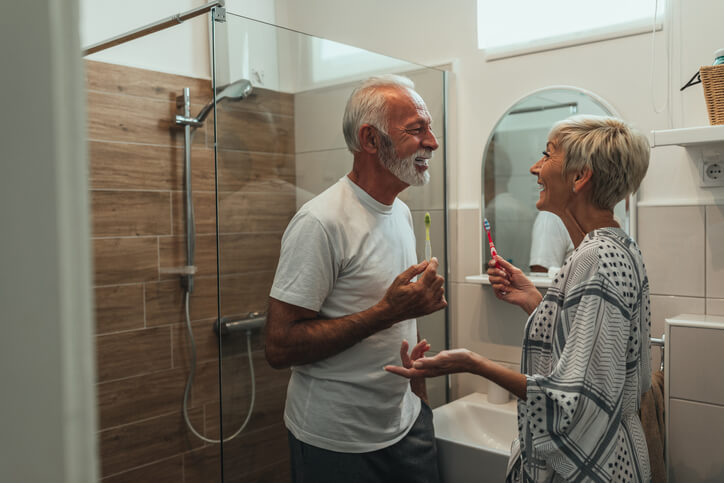“How to brush your teeth” … that sounds simple, right? But no one is born knowing how to brush their teeth. And what seems like a good idea – brush firmly, back, and forth, with a hard brush, get those teeth really clean! – can actually injure your tooth enamel and hurt your gums. Here’s what you need to know about keeping your teeth clean, strong, and healthy.
First, Know Your Tooth Enamel
Your dental enamel, the hard outer covering of your teeth, is comprised of tiny, tightly packed rods of minerals. You have about 5 million rods in the lower lateral incisor and up to 12 million in the upper first molar.
Then ask…
Am I brushing my teeth, right?
Brushing your teeth with a side-to-side motion goes against the orientation of the enamel rods in your teeth, which can cause the rods to weaken and break. Instead, position your toothbrush’s bristles at a 45-degree angle to the surface of the teeth and brush gently in small circles.
Research shows that brushing for at least three minutes is a good idea – and most of us only spend 45 seconds to cleaning our teeth.
How long should I brush my teeth for?
“Brushing for 180 seconds removed 55% more plaque than brushing for 30 seconds. Brushing for 120 seconds removed 26% more plaque than brushing for 45 seconds. The use of dentifrice (toothpaste) did not increase plaque removal during 60 seconds of brushing.”
Dental plaque is a sticky, colorless or pale-yellow bacterial film that begins forming on your teeth 4-12 hours after brushing. When left alone on the surfaces of your teeth, plaque bacteria metabolize sugars from the foods you eat and release acids as byproducts. The acids, in turn, begin eating away at your tooth enamel. Soon, a small hole (cavity) will likely begin to form in the outer layers of the tooth. If left untreated, the decay can continue eating away at the tooth structure, and the bacteria can reach deeper inside the tooth. This can eventually make it necessary for you to have root canal treatment—or even to have the tooth extracted.
Brushing and flossing (typically twice a day unless your dentist recommends more) is key to keeping your teeth and gums healthy.
Should I floss or brush first?
Get the hidden debris out from between your teeth prior to brushing. Flossing is essential to your oral health because it helps remove harmful plaque bacteria from areas where your toothbrush simply can’t reach. These bacteria cause tooth decay (cavities) and gum disease—and if not cleared from tooth surfaces regularly, they harden into a tough coating called tartar (dental calculus), which must be removed via a professional cleaning. Don’t like to floss? Consider interdental products such as powered air or water flossers, or small interdental brushes designed to clean between teeth to step up your dental hygiene routine. Talk to your dentist or dental hygienist about which interdental options can best support your dental health.
Choosing a Toothbrush
Get yourself a soft-bristled toothbrush with a head that’s small enough to reach all areas in your mouth. Replace that brush every three months – or sooner if the bristles are worn, bent, or frayed. Also, replace your toothbrush if you’ve just recovered from a cold, the flu, or another ailment. Germs like to lurk in you toothbrush’s bristles.
You may want to talk to your dentist or dental hygienist about electronic toothbrushes or the newer brushes that use ultrasound to destroy bad bacteria and debris. But a plain old toothbrush will do just fine, for most people.
Toothbrushing Tips
If you like listening to music, try brushing for the length of one song: about two or three minutes. You should thoroughly brush all tooth surfaces—that means the outside, inside, and chewing surfaces of the teeth—for at least two minutes, at least twice per day.
If you or your kids have braces, make sure to carefully clean around the brackets and in the spaces between wires and teeth, where food particles can become trapped and lead to decay; the same goes for the areas between brackets and gums.
After you brush, remember to remove the bacteria and food particles that reside on your tongue by brushing it gently with your (soft) toothbrush or a tongue scraper.
And lastly, rinse with plain water or a mouthwash, and you’re done!
See Your Dentist and Hygienist Regularly
No matter how devoted you are to at home care, regular exams and professional teeth cleanings are critical. Checkups involve more than a quick peek at your teeth – your dentist will screen you for oral cancer, tooth decay and gum disease. Caught early, these conditions are far easier to manage.
Even people who are super-dedicated to good oral hygiene will inevitably miss a bit of plaque here and there, which can harden into tartar. Removing tartar is not something that you can do at home, without risking the chance that you’ll cause more dental damage with abrasive toothpastes, scraping, and/or other DIY dental tricks that you should avoid. Your hygienist will safely clean hardened dental plaque that’s impossible to remove at home and remove any trapped debris.
Your dental care team is the absolute best source of information on oral hygiene practices and addressing your oral health concerns. Don’t wait until a problem arises to check in with your dentist!
And if you’ve been skipping regular checkups and cleanings due to budget concerns or no dental insurance, consider getting a dental savings plan. These plans are an affordable alternative to dental insurance, providing plan members with discounts of 10-60% on the majority of dental procedures. Learn more about dental savings plans today!

 Login
Login